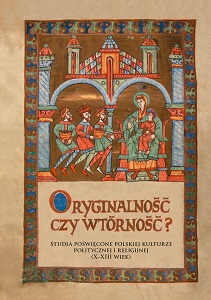Regnum in se divisum. Ku syntezie kultury politycznej Piastów doby dzielnicowej
Regnum in se divisum. Towards a synthesis of the political culture of the Piast dynasty during the period of divisions
Author(s): Marcin Rafał Pauk
Subject(s): Middle Ages, 6th to 12th Centuries, 13th to 14th Centuries, 15th Century
Published by: Wydawnictwa Uniwersytetu Warszawskiego
Keywords: medieval history; church history; Christianity in the Middle Ages; religious culture; Poland during the Piast dynasty
Summary/Abstract: Polish political culture in the epoch traditionally referred to as feudal fragmentation (around 1200–1320) needs to be re-examined, taking into account the comparative perspective. Commonly followed interpretative frameworks of historiography, which universalize in an a-historical way the value of the national unitary state, should be revised. The concept of a “unifying ideology” as an actual political program of the second half of the 13th century, which has organized discourse thus far, seems to be incompatible with the political principles of the epoch. This study is an attempt at identifying the key elements of the political culture of the time from the perspective of their originality and imitativeness. The first part is focused on the issue of defining the position of dukes using categories of widely understood honour and on the concepts of equality, freedom, and the equality of the legal status, determining the position of male members of the dynasty in relation to each other. Their analysis leads to the conclusion that in the 13th century the Piasts did not recognize any formal hierarchy within the dynasty, apart from generational seniority, understood more as a formality. They respected the right to rule of side Piast branches in their hereditary lands, although the conflict over power in Greater Poland after Władysław III’s death constituted an exception to the rule. The second part of the article is devoted to family strategies of the Piasts, which guaranteed the dynasty’s cohesion despite its many branches, for example the matrimonial strategies (especially endogamous marriages), relations of artificial kinship (adoptions and baptismal adoptions), the issue of dynastic divisions within the regions and ways of preventing them, and finally the dynastic naming strategies.
- Page Range: 76-163
- Page Count: 88
- Publication Year: 2020
- Language: Czech, Polish
- Content File-PDF

